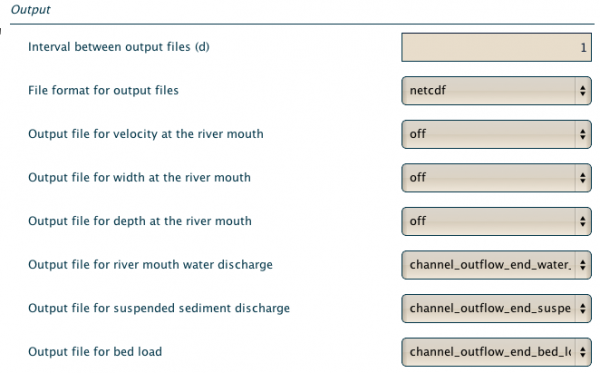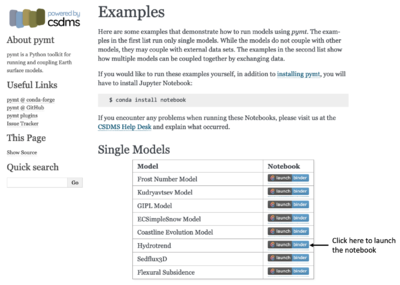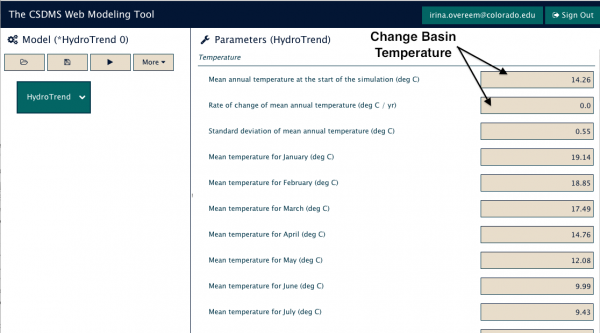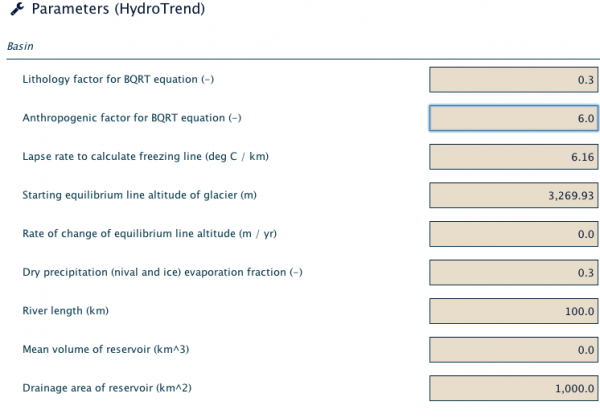Labs WMT River Sediment Supply: Difference between revisions
| Line 28: | Line 28: | ||
'''Lab Notes''' | '''Lab Notes''' | ||
You can launch binder to directly run the Jupyter Notebook for this lab through a web browser. | |||
>> Open a new browser window and open the Pymt read the docs page [https://pymt.readthedocs.io/en/latest/examples.html here] | >> Open a new browser window and open the Pymt read the docs page [https://pymt.readthedocs.io/en/latest/examples.html here] | ||
[[File:launch_binder_hydrotrend2.png|400px]] | |||
>> You will see that there are several example models. In this lab we will select the HydroTrend model. <br> | |||
>> You will see that there are several example models. In this lab we will select the | |||
>> Click on the 'Launch Binder' box and it will allow you to see this lab as a Jupyter Notebook.<br> | >> Click on the 'Launch Binder' box and it will allow you to see this lab as a Jupyter Notebook.<br> | ||
>> You can execute the Jupyter notebook code cells using shift -enter. | >> You can execute the Jupyter notebook code cells using shift -enter. | ||
Revision as of 11:51, 19 March 2020
River Sediment Supply Modeling with HydroTrend
HydroTrend is a 2D hydrological water balance and transport model that simulates water discharge and sediment load at a river outlet. You can read more about the model, find references or download the C source code at: https://csdms.colorado.edu/wiki/Model:HydroTrend.
In this lab, we are using a theoretical river basin of ~1990 km2, with 1200m of relief and a river length of ~100 km. All parameters that are shown by default once the HydroTrend Model is loaded are based on a present-day, temperate climate. Whereas these runs are not meant to be specific, we are using parameters that are realistic for the Waiapaoa River in New Zealand. The Waiapaoa River is located on North Island and receives high rain and has erodible soils, so the river sediment loads are exceptionally high. It has been called the 'dirtiest small river in the world'. A more detailed description of applying HydroTrend to the Waipaoa basin, New Zealand has been published in WRR: hydrotrend_waipaoa_paper. To learn more about HydroTrend and its approach to sediment supply modeling, you can download this presentation.
This lab will run HydroTrend simulation with Python Modeling Tool (Pymt). If you have never used the Pymt, learn how to use it here. The Pymt allows you to set up simulations and run notebooks.
If you are a faculty at an academic institution, it is possible to work with us to get temporary teaching accounts. Work directly with us by emailing: csdms@colorado.edu
Learning objectives
Skills
- use Pymt to run HydroTrend Model
- familiarize with a basic configuration of the HydroTrend Model
- make small changes to key input parameters
- hands-on experience with visualizing output in Python
Topical learning objectives:
- explore the HydroTrend base-case river simulation
- how does a river system respond to climate change
- how do human affect river sediment loads
Lab Notes
You can launch binder to directly run the Jupyter Notebook for this lab through a web browser.
>> Open a new browser window and open the Pymt read the docs page here
>> You will see that there are several example models. In this lab we will select the HydroTrend model.
>> Click on the 'Launch Binder' box and it will allow you to see this lab as a Jupyter Notebook.
>> You can execute the Jupyter notebook code cells using shift -enter.
Exercise 1: Explore the base-case river simulation
>> Reset the default parameters to define a “base-case” simulation for 50 years at daily time-step. This means you run Hydrotrend for 18,250 days total.
>> Scroll down to find the output settings. Specify a number of output files to generate after the simulation: these are netCDF files of water discharge, suspended sediment, and bedload. Make sure the output interval is set to 1 (every timestep).


>> Now save and run the simulation!
>> Download the output files from the status window. You can download the netCDF files and use Panoply to visualize your results. For simple analysis of the output, like calculating the average river characteristics or peak events, it is easiest to grab the HydroTrend ASCII files and use either Python, or Excell, or Matlab to work with the data.
Question 1a Calculate mean water discharge Q, mean suspended load Qs, mean sediment concentration Cs, and mean bedload Qb. Note all values are reported as daily averages. Q= m3/s, Cs=kg/m3, Qs =Qb = kg/s.
Question 1b Identify the highest flood event for this simulation. Is this the 50-year flood? Plot the year of Q-data which includes the flood.
Question 1c Calculate the mean annual sediment load for this river system.
Question 1d To compare the mean annual load to other river systems you will need to calculate its sediment yield. Sediment Yield is defined as sediment load normalized for the river drainage area; so it can be reported in T/km2/yr. How does the sediment yield of this river system compare to the present-day Mississippi River?
Exercise 2: How does a river system respond to climate change; a few simple scenarios for the coming century.
Now we will look at changing climatic conditions in a small river basin. We'll change temperature and precipitation regimes and compare discharge and sediment load characteristics to the original basecase. And we will look at the are potential implications of changes in the peak events.
>>Use the temperature and precipitation tabs to modify the mean annual temperature T, the mean annual precipitation P, and its the variability of the yearly means through the standard deviation. You can specify trends over time, by modifying the parameter ‘change in mean annual temperature’ or ‘change in mean annual precipitation’. HydroTrend runs at daily timestep, and thus can deal with seasonal variations in temperature and precipitation for a basin. The model ingests monthly mean input values for these two climate parameters and their monthly standard deviations, ideally the values would be derived from analysis of a longterm record of daily climate data. You can adapt seasonal trends by using the monthly values.
Question 2a Explore the effect of a warming climate. What happens to discharge, suspended load and bedload if the mean annual temperature in this specific river basin increases by 4 °C over 50 years?
Question 2b Explore the effect of a 100% increase of precipitation over the next 50 years. How much increase of discharge do you see after 50 years? How is the average suspended load affected? How does the bedload change? What happens to the peak event; look at the maximum discharge event of the last 10 years of the simulation?
Question 2c In addition, climate model predictions indicate that perhaps precipitation intensity and variability could increase. How would you model this; discuss all your input settings for precipitation.
Exercise 3: How do humans affect river sediment loads?
Here we will look at the effect of human in a river basin. Humans can accelerate erosion processes, or reduce the sediment loads traveling through a river system. Both concepts can be simulated, first run 3 simulations systematically increasing the anthropogenic factor (0.5-8.0 is the range).
Question 3a Describe in your own words the meaning of the human-induced erosion factor, (Eh) (Syvitski & Milliman, 2007). This factor is parametrized as the “Antropogenic” factor in HydroTrend. See references for the paper.
>> Model a scenario of a drinking water supply reservoir to be planned in the coastal area of the basin. The reservoir would have 800 km 2of contributing drainage area and be 3 km long, 200m wide and 100m deep. Set up a simulation with these parameters.
Question 3b How would such a reservoir affect the sediment load at the coast (i.e. downstream of the reservoir)?



